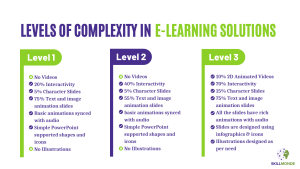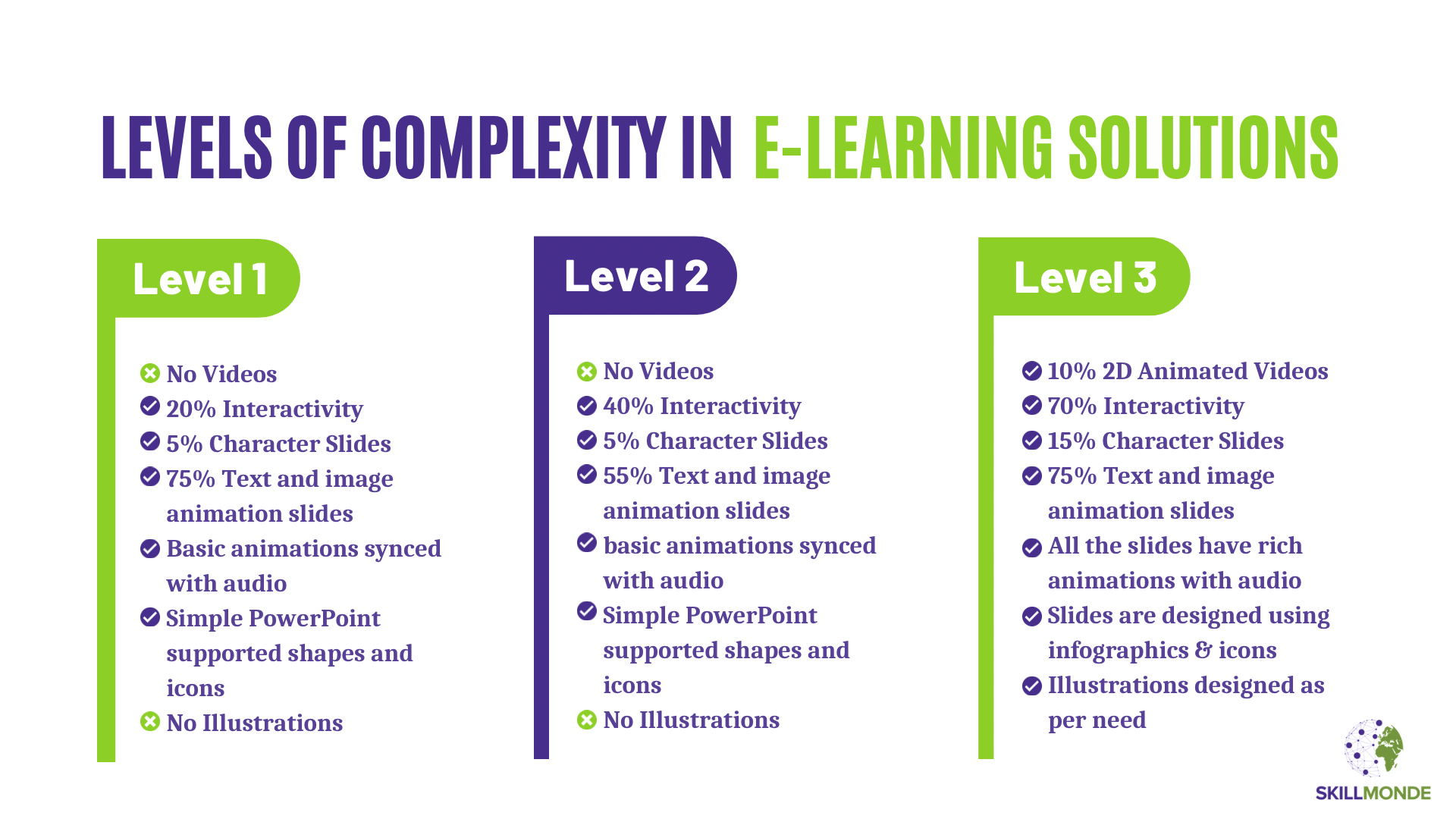E-learning has revolutionized education, transforming the way we learn. As an experienced e-learning expert, I've seen the growth of e-learning complexity. In this blog, we'll explore different complexity levels in e-learning and how they cater to diverse learning needs. We'll also highlight popular e-learning authoring tools for each level.
Level 1: Simple and Easy
At this level, courses offer basic information suitable for all learners. They include static content with text, images, and occasional videos or audio.
Recommended Tools:
• PowerPoint: Perfect for creating simple content-based courses.
• Google Slides: Useful for collaborative content creation and basic presentations.
• Articulate Rise: Enables quick content creation with a user-friendly interface.
Level 2: Interactive and Engaging
Level 2 courses are more engaging, encouraging active participation. They have quizzes, assessments, and may include gamification elements. Learners can interact with multimedia content like videos and animations.
Recommended Tools:
• Articulate Storyline: Offers interactivity and multimedia capabilities.
• Adobe Captivate: Creates interactive simulations and responsive content.
• Vyond (formerly GoAnimate): Great for making engaging animated videos.
Level 3: Multimedia-Rich and Immersive
At this level, e-learning embraces multimedia and immersive experiences. Learners engage with video lectures, 3D animations, VR, and AR simulations.
Recommended Tools:
• Articulate Storyline: Creates multimedia-rich courses with animations.
• iSpring Suite: Provides interactive elements and multimedia features.
• Unity3D and Unreal Engine: Used for advanced VR and AR experiences.
Level 4: Adaptive and Personalized
Level 4 e-learning offers personalized learning experiences. It customizes content based on learners' progress and preferences using adaptive learning technologies.
Recommended Tools:
• Adapt: Open-source tool for responsive and mobile-friendly courses.
• Smart Sparrow: Provides adaptive features and personalized learning paths.
• Learning Management Systems (LMS) with built-in adaptive capabilities.
Level 5: Collaborative and Social Learning
At the highest level, e-learning focuses on collaboration and social learning. Learners interact with peers, engage in group discussions, and provide real-time feedback.
Recommended Tools:
• Learning Management Systems (LMS) with social learning features.
• Microsoft Teams, Slack, or similar platforms for collaboration.
• H5P: Enables interactive content creation for social learning.

Level of complexity in eLearning Solutions
E-learning offers a wide range of complexity levels, catering to diverse learning needs. Using the right authoring tools, educators and designers can create transformative e-learning experiences for learners worldwide, empowering them to succeed in an ever-changing world.
Q1: What are the different complexity levels in e-learning?
A1: E-learning encompasses various complexity levels, ranging from simple and straightforward courses to more immersive and adaptive experiences.
Q2: What does Level 1 e-learning entail? A2: Level 1 e-learning involves basic courses with static content, such as text and images, suitable for learners new to online education.
Q3: Can you provide examples of Level 2 e-learning courses?
A3: Level 2 e-learning includes interactive and engaging courses with multimedia elements, quizzes, and gamification features.
Q4: How do Level 3 e-learning courses differ from other levels?
A4: Level 3 e-learning focuses on multimedia-rich and immersive experiences, incorporating videos, animations, and virtual reality (VR) simulations.
Q5: What makes Level 4 e-learning adaptive and personalized?
A5: Level 4 e-learning utilizes adaptive learning technologies to customize content based on learners' progress and preferences, providing a tailored learning experience.
Q6: Are Level 5 e-learning courses collaborative in nature?
A6: Yes, Level 5 e-learning emphasizes collaboration and social learning, promoting peer-to-peer interaction and group discussions.
2. FAQs about Tools Used in E-Learning:
Q1: What are e-learning authoring tools, and why are they important?
A1: E-learning authoring tools are software applications that allow course creators to design, develop, and publish online courses. They are essential for creating engaging and interactive e-learning content.
Q2: Which authoring tools are suitable for Level 1 e-learning?
A2: For Level 1 e-learning, basic e-learning authoring tools like PowerPoint, Google Slides, and Articulate Rise can be used to create simple courses.
Q3: Which tools are best for creating interactive content at Level 2?
A3: Articulate Storyline, Adobe Captivate, and iSpring Suite are popular authoring tools for Level 2 e-learning with interactive elements and multimedia capabilities.
Q4: Can you recommend tools for Level 3 e-learning with immersive experiences?
A4: For Level 3 e-learning, tools like Articulate Storyline, Vyond (formerly GoAnimate), and Unity3D are used to create multimedia-rich and immersive courses.
Q5: How do adaptive learning tools fit into Level 4 e-learning?
A5: Level 4 e-learning benefits from tools like Adapt and Smart Sparrow, which enable personalized learning experiences by adjusting content based on learners' interactions and progress.
Q6: What are some tools for facilitating collaboration in Level 5 e-learning?
A6: Learning Management Systems (LMS) with social learning features, along with platforms like Microsoft Teams and Slack, can enhance collaboration and peer-to-peer interaction in Level 5 e-learning.
Q7: Can I use multiple authoring tools for different complexity levels in e-learning?
A7: Yes, course creators often leverage a combination of authoring tools to cater to different complexity levels and specific learning objectives.
These FAQs can provide learners and course creators with valuable insights into the different complexity levels of e-learning and the tools available to create engaging and effective online courses.
